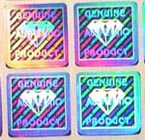|
Hologram News part just showes the updated Hologram Technology and Hologram News in the world to any reader. All news are from Internet and newpaper. This is not for commercial purpose. If there's mistake, please contact us to correct it.
Hungarian holographic specialists Holografika will show IBC visitors a new 30” HoloVizio monitor which uses light-field technology to offer viewers true glasses-free 3D video.
The new 30” HoloVizio 80WLT will be targeted towards the professional markets such as medical and visualisation rather than home entertainment (for now) but it avoids the many limitations of lenticular technology with continuous parallax in the entire field-of-view, allowing people to even look behind objects. There are no sweet spots, invalid zones or repeated views and viewers can be positioned anywhere in front of the display. The full-angle geometrically correct view is achieved through reconstructing all the light beams leaving the holoscreen even under extreme angles in a range up to 180 degrees.
The 3D image is built up by 73 million pixels and therefor the monitor requires multiple dual-DVI inputs to cope with the huge bandwidth needed to construct the 3D images.
The development of the display and the related technologies was partially supported by the 3D VIVANT European FP7 project which investigates the possibility of using different technologies for capture and display of 3D content. 3D VIVANT proposes to use advanced 3D holoscopic imaging methodology, which uses the principle of “Fly’s eye” and hence allows natural viewing of objects and the capture of 3D holoscopic content using an array of microlenses in a single aperture camera setup. (You can watch an interesting video on the 3D VIVANT website).

Tibor Balogh, Holografika CEO said: ”We are always pushing boundaries to show people what 3D should look like. There is certain disillusion around stereo glasses or some multiview systems with artificial 3D effects. Full-angle view is a milestone again in 3D technologies. The image that does not disappear, 3D objects that are solidly there as you walk around, give an unprecedented level of reality. The hologram-like 3D visual impression is different and this is what people expect in the future.”
Hologram classifications There are three important properties of a hologram which are defined in this section. A given hologram will have one or other of each of these three properties, e.g. we can have an amplitude modulated thin transmission hologram, or a phase modulated, volume reflection hologram. it is made up of virtual systems.
Rainbow holograms Rainbow hologram showing the change in colour in the vertical direction
In this method, parallax in the vertical plane is sacrificed to allow a bright well-defined single colour re-constructed image to be obtained using white light. The rainbow holography recording process uses a horizontal slit to eliminate vertical parallax in the output image. The viewer is then effectively viewing the holographic image through a narrow horizontal slit. Horizontal parallax information is preserved but movement in the vertical direction produces colour rather than different vertical perspectives.[40] Stereopsis and horizontal motion parallax, two relatively powerful cues to depth, are preserved.
The holograms found on credit cards are examples of rainbow holograms. These are technically transmission holograms mounted onto a reflective surface like a metalized polyethylene terephthalate substrate commonly known as PET.
How hologram color been made?
Holograms are shooted by laser beam in different angles which figure out different colors - red, green, blue, yellow, etc, in difference viewing angles. C olors of the hologram will change, because when rainbow hologram is turned back and forth depending on the light source and viewing angle, the colors will run through the spectrum - the colors of the rainbow.
Different viewing depth of hologram comes from different position of the artwork film we locate when shooting master. Dot-matrix movement efffect comes from countinous hologram dots.
How does design show hologram color?
Holograms artwork design are basically an illusion; they are reflections of light that fool the eye into seeing a three-dimensional image. Therefore, it is impossible to give an accurate representation of a holographic image on a computer screen or paper printout. What you will receive via email or hardcopy is an artwork proof to look over to be sure that the graphics and layout are to your liking, free of typos, etc. The holographic master shooting process involves many detailed steps, so it is very important that all hologram artwork is approved before the project moves into the laser lab for holographic mastering.
How to make artwork for holographic sticker?
Holograms can be made from photos, flat art which is designed by Corel Draw, Illustrator, Photoshop or other software.Artwork file in Corel Draw or Illustrator format is best file for us to seperate overlay design into layers and colors. Adobe Photoshop file, JPG, GIF, is ok, if you cannot design by Corel Draw or Illustrator. The text in artwork file should be converted into curves, so we can open it without change font in it.
Design and sample photo:
A. 2D/3D, size 19mm*19mm, square, three layers, six color
  
It has three layers, foreground, background and floating layer. There're three color on foreground, two color in background and one color in floating layer. So it has six colors and three layers.
|



 07000688
07000688